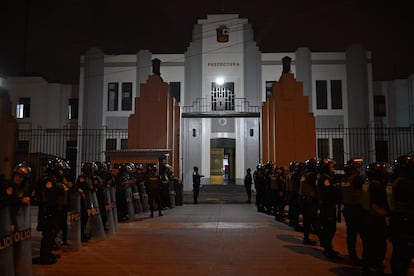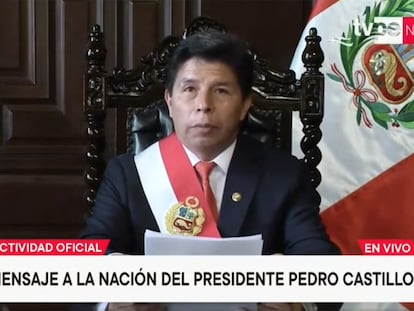The 180 minutes that made Peru tremble
Pedro Castillo ended up under arrest and charged with rebellion after his failed attempt to dissolve Congress and install an emergency government

In the early days of his presidency, he was acclaimed by crowds in public squares as the humble man representing those who had never held power in Peru. On Wednesday, following a crazy plan that lasted three hours, finding himself alone and with no support, his days in government ended with a last-ditch attempt to seek refuge in the Mexican Embassy, according to several sources.
Pedro Castillo, the rural school teacher who went to vote in the 2021 presidential elections on the back of a horse, was able to take advantage of Peru’s political crisis to rise to power. But he never really managed to take control of the government. His own security detail escorted him to a Lima police station on Wednesday, where he was later photographed reading a magazine, seemingly unconcerned by the situation.
That scene of tranquility was fictitious. Just three hours earlier, Castillo had announced what amounted to a self-coup to cling to power, as former president Alberto Fujimori did in his day. But unlike the latter, Castillo did not have the support of the military, business leaders or the media. And his demeanor on television was not that of a true autocrat, either. On Wednesday, the president’s hands were trembling as they held the paper he was reading; words came out of his mouth awkwardly, and his eyes were as wide as those of an animal caught in the headlights of an approaching truck.
His challenge to the constitutional order lasted only as long as it took the military to issue a brief statement announcing that they did not support his move. On Wednesday, the president had been facing the third attempt by Congress to impeach him. The attempt would have likely failed, as it did not have the backing of two-thirds of the chamber as required. In fact, Castillo was experiencing a rebound in his popularity after almost hitting rock bottom. His continued visits to rural areas, where his victory was forged, were starting to pay off. No one predicted that he would jump out of the window.
Yet he did. Castillo had grown tired of dealing with Congress, which has even less political credibility than he does. He was feeling persecuted by a counterpower that prevented him from even traveling abroad, and blamed this other power for his numerous political ills. In the year and a half that he was president, he was unable to maintain a stable cabinet. He was hounded by corruption cases involving himself and officials around him, and these investigations were being pursued more diligently than ever before. He never had the support of the establishment, and this fact was made more evident than ever by Castillo’s political suicide. The president was all alone. His own guards turned him over to the authorities.
Castillo’s tenure has been a continuous succession of curves. In recent months he had received support from other left-wing presidents in the region, but only after his ambassadors complained to the presidents of Mexico, Colombia, Chile and Argentina. Within the progressive alliance that has emerged from recent elections in Latin America, Castillo was a strange object who never really fit in.
He started out with a government made up of modern politicians, feminists, educated individuals who enjoyed some level of prestige. But they soon abandoned Castillo’s project because of his erratic style. He then surrounded himself with ultra-conservative and conspiratorial people. Things went from bad to worse. In the year and a half that he was in power, he changed 50 ministers and appointed five presidential cabinets. He survived two impeachment attempts and would have probably survived the third on Wednesday, although it is likely that there would have been a fourth later on. His government was a non-government. So he decided to blow everything up.
He came to power as the representative of change, as the outsider who had come to end the political crisis. Instead, he succumbed to the same fate as his predecessors. All living former presidents since 1990 have been investigated. Castillo is now starting down that path, and adding to the penalties that might befall him for the corruption cases, there is now a charge of rebellion that could keep him behind bars for anywhere between 10 and 20 years.
Peruvians who rushed home on Wednesday amid traffic chaos after hearing the president’s announcement ended the day making jokes about the latest of their national political disasters. But the situation is more similar to a drama than a comedy. Peru and its 33 million inhabitants have been mired in a deep institutional crisis for six years. Corruption and cronyism dominate a fragmented Congress that manipulates weak presidents and minority benches at will.
Castillo on Wednesday announced the dissolution of Congress, yet congressmembers remained at their posts. Instead, they brought forward the impeachment session and approved his dismissal by a majority. At that point, the president knew that there was no longer anything he could do. The adventure had ended even before it began. He asked his people to take him to the Mexican Embassy, although it is not clear if he had communicated his desire to seek refuge to the López Obrador administration. But his own people led him to the same place where others like him, who one day tried to lead Peru, all ended up: in police custody.
Seeing a president in jail will not come as a surprise to a country that has seen it all in politics. Former president Alejandro Toledo is out on bail in the United States; Alan García committed suicide before he was sentenced to pretrial detention; Ollanta Humala was in pretrial detention, although he is now free; Pedro Pablo Kuczynski is under house arrest; Martín Vizcarra is free, but under investigation. Alberto Fujimori is for now the only one serving an effective prison term. Castillo looks set to follow in his wake. Except that Fujimori’s self-coup lasted 13 years, until he was arrested in Chile in 2005, while Castillo’s lasted just three hours.
Sign up for our weekly newsletter to get more English-language news coverage from EL PAÍS USA Edition
Tu suscripción se está usando en otro dispositivo
¿Quieres añadir otro usuario a tu suscripción?
Si continúas leyendo en este dispositivo, no se podrá leer en el otro.
FlechaTu suscripción se está usando en otro dispositivo y solo puedes acceder a EL PAÍS desde un dispositivo a la vez.
Si quieres compartir tu cuenta, cambia tu suscripción a la modalidad Premium, así podrás añadir otro usuario. Cada uno accederá con su propia cuenta de email, lo que os permitirá personalizar vuestra experiencia en EL PAÍS.
¿Tienes una suscripción de empresa? Accede aquí para contratar más cuentas.
En el caso de no saber quién está usando tu cuenta, te recomendamos cambiar tu contraseña aquí.
Si decides continuar compartiendo tu cuenta, este mensaje se mostrará en tu dispositivo y en el de la otra persona que está usando tu cuenta de forma indefinida, afectando a tu experiencia de lectura. Puedes consultar aquí los términos y condiciones de la suscripción digital.
More information
Archived In
Últimas noticias
The new victims of the Republican war on Obamacare: Millions hit by soaring health insurance premiums
A country divided on migrant rights: Some US states expand protections while others restrict them
Venezuela authorizes the release of another 87 political prisoners
There is as much life left to discover on planet Earth as that which is already known
Most viewed
- David King, chemist: ‘There are scientists studying how to cool the planet; nobody should stop these experiments from happening’
- Reinhard Genzel, Nobel laureate in physics: ‘One-minute videos will never give you the truth’
- Oona Chaplin: ‘I told James Cameron that I was living in a treehouse and starting a permaculture project with a friend’
- Sinaloa Cartel war is taking its toll on Los Chapitos
- The Interoceanic Train, the Mexican alternative to the Panama Canal










































